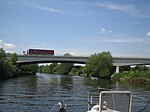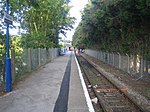Sir William Borlase's Grammar School Boat Club
BishamBuildings and structures on the River ThamesRowing club stubsRowing clubs in EnglandRowing clubs of the River Thames ... and 2 more
Scholastic rowing in the United KingdomSport in Buckinghamshire

Sir William Borlase's Grammar School Boat Club is a rowing club on the River Thames based at Longridge, Quarry Wood Road, Marlow. The club belongs to the Sir William Borlase's Grammar School. The club shares the boathouse facility with Great Marlow School Boat Club.The club won the prestigious Fawley Challenge Cup three times at the Henley Royal Regatta.The club has also produced multiple British champions.
Excerpt from the Wikipedia article Sir William Borlase's Grammar School Boat Club (License: CC BY-SA 3.0, Authors, Images).Sir William Borlase's Grammar School Boat Club
Quarry Wood Road,
Geographical coordinates (GPS) Address Website Nearby Places Show on map
Geographical coordinates (GPS)
| Latitude | Longitude |
|---|---|
| N 51.564311 ° | E -0.760862 ° |
Address
Longridge Activity Centre
Quarry Wood Road
SL7 1QG , Bisham
England, United Kingdom
Open on Google Maps








